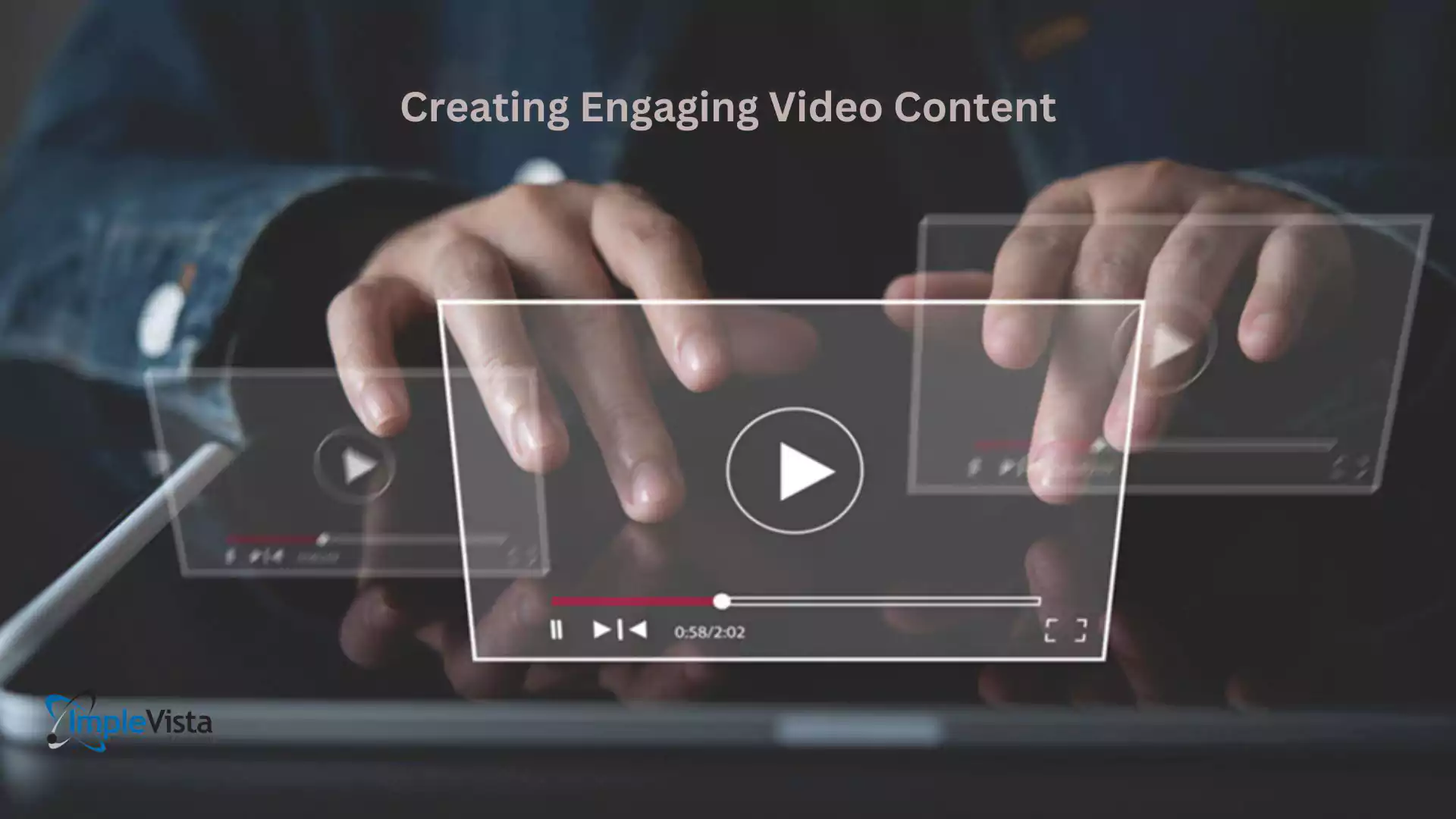Video marketing has become an indispensable tool for businesses, offering a dynamic way to communicate with audiences and drive engagement. For Bangladeshi businesses, platforms like YouTube and TikTok present immense opportunities to reach diverse demographics. From storytelling to showcasing products, video content resonates with audiences, making it a vital part of any marketing strategy.
At Digital Implevista, we specialize in crafting tailored video marketing strategies for businesses in Bangladesh, helping them leverage these platforms to their full potential. This article dives into the latest video marketing trends, actionable tips, and platform-specific strategies, demonstrating how Digital Implevista empowers businesses to succeed.
What is Video Marketing?
Video marketing involves the creation, optimization, and distribution of video content to promote products or services, engage with audiences, and drive conversions. It’s not just about making a video—it’s about strategically crafting content that aligns with your brand’s goals and resonates with your target audience.
Key elements of video marketing include:
- Video SEO: Optimizing videos with relevant keywords, captions, and descriptions to improve their visibility on search engines.
- Distribution: Sharing videos across various platforms like YouTube, Instagram, TikTok, or even embedding them in websites.
- Analytics: Tracking performance metrics such as view counts, engagement rates, and conversion rates to measure success.
Why Video Marketing Matters in Bangladesh
- Massive Reach
Platforms like YouTube and TikTok are among the most popular in Bangladesh. With millions of active users, businesses can tap into a broad audience base. - Higher Engagement Rates
Videos are more engaging than static content, with users spending more time watching videos than reading text or viewing images. - Effective Storytelling
Video content allows businesses to tell their brand story, build trust, and connect emotionally with their audience. - Boosts SEO and Visibility
Videos are prioritized in search engine results, especially for YouTube, a platform owned by Google.
Trends in Video Marketing for Bangladeshi Businesses
- Short-Form Videos
TikTok has popularized bite-sized, engaging content. Short-form videos are now a key trend, appealing to users with limited attention spans. - Live Streaming
Live videos on YouTube and TikTok allow businesses to interact with their audience in real-time, boosting authenticity and engagement. - Localized Content
Videos in Bangla or reflecting local culture resonate strongly with Bangladeshi audiences. - Shoppable Videos
Integrating e-commerce features into videos allows viewers to purchase directly, bridging entertainment and commerce.
Social Media Video Marketing Strategy:
A social media video marketing strategy is a plan for using video content to promote your brand, engage your audience, and achieve marketing goals on social platforms like Facebook, Instagram, YouTube, TikTok, LinkedIn, and Twitter (now X). It involves creating engaging, high-quality videos that align with your brand and leveraging them to increase visibility, build relationships, and drive conversions.
Why Use Video Marketing on Social Media?
- Higher Engagement: Videos outperform other content types in terms of likes, shares, and comments.
- Better Reach: Social platforms prioritize video content, making it more likely to appear in user feeds.
- Improved Retention: Videos convey messages faster and are more memorable than text or images.
- Versatility: Videos can be used for storytelling, product showcases, tutorials, and much more.
Key Elements of a Social Media Video Marketing Strategy
1. Define Your Goals
- Identify what you want to achieve with your videos:
- Build brand awareness
- Drive traffic to your website
- Increase sales
- Educate your audience
- Engage followers with interactive content
2. Understand Your Target Audience
- Research your audience’s demographics, preferences, and habits.
- Identify the platforms they use most (e.g., younger audiences prefer TikTok and Instagram, while professionals are active on LinkedIn).
3. Choose the Right Platforms
- Focus your efforts on the platforms that align with your goals and audience:
- Instagram and Facebook: Short, engaging videos for stories, reels, or posts.
- YouTube: Long-form videos like tutorials, vlogs, or product reviews.
- TikTok: Trend-driven, short, creative videos.
- LinkedIn: Professional and educational video content.
- Twitter (X): Short, impactful videos for quick engagement.
4. Develop a Content Plan
- Content Types:
- Product Demos: Showcase how your product works.
- Tutorials: Teach something valuable to your audience.
- Behind-the-Scenes: Offer a glimpse into your company’s culture or processes.
- User-Generated Content (UGC): Share videos created by your customers.
- Live Videos: Host Q&A sessions, product launches, or webinars.
- Testimonials: Highlight satisfied customer experiences.
- Content Calendar: Plan when and where to post videos for consistent engagement.
5. Focus on Storytelling
- Use videos to tell stories that resonate emotionally with your audience. A compelling narrative keeps viewers engaged and strengthens brand loyalty.
6. Keep Videos Short and Engaging
- Attention spans are shorter on social media. Aim for:
- 15-30 seconds for TikTok, Instagram Reels, and Facebook Stories.
- 1-2 minutes for YouTube or LinkedIn videos.
7. Add Clear CTAs (Call-to-Actions)
- Encourage viewers to take action:
- “Visit our website.”
- “Follow us for more updates.”
- “Comment below with your thoughts.”
8. Optimize for Each Platform
- Tailor your video format, length, and content style to suit each platform:
- Vertical videos for TikTok, Instagram Stories, and Reels.
- Horizontal videos for YouTube and Facebook.
- Subtitles for sound-off viewing (many users watch videos without sound).
Tips for Effective Social Media Video Marketing
- Start Strong: Hook your audience within the first 3-5 seconds.
- Use Captivating Thumbnails: A visually appealing thumbnail encourages clicks.
- Leverage Trends: Use trending music, challenges, or hashtags to boost discoverability.
- Post Consistently: Regularly upload videos to stay top-of-mind with your audience.
- Engage Your Audience: Respond to comments and encourage interaction.
- Test and Iterate: Analyze performance metrics (likes, shares, view time, etc.) to refine your approach.
Best Practices by Platform
1. Instagram
- Focus on Reels and Stories for short, engaging content.
- Use carousel posts to combine videos and images for storytelling.
2. TikTok
- Be creative, authentic, and trend-savvy.
- Leverage TikTok ads for broader reach.
3. YouTube
- Create high-quality, educational, or entertaining long-form videos.
- Use YouTube Shorts for quick, impactful messages.
4. Facebook
- Share live videos and short clips for maximum engagement.
- Experiment with video ads targeting specific demographics.
5. LinkedIn
- Focus on professional, educational content.
- Share case studies, thought leadership, and behind-the-scenes insights.
Measuring Success
Track performance using platform-specific analytics:
- Engagement Metrics: Likes, shares, and comments.
- View Metrics: Total views, average watch time, and view completion rates.
- Conversions: Click-through rates (CTRs), sign-ups, or sales driven by video content.
A successful social media video marketing strategy combines creativity, audience insights, and platform optimization to maximize engagement and ROI. By creating consistent, high-quality video content tailored to your audience’s preferences, you can effectively promote your brand and drive meaningful results.
Why Use YouTube and TikTok for Video Marketing?
YouTube and TikTok are two of the most popular platforms for video marketing, each with distinct features and audiences. A well-crafted strategy for these platforms can help businesses effectively engage their target audience, build brand awareness, and drive conversions.
YouTube:
- Massive Audience: Over 2 billion monthly active users globally.
- Longer Content Lifespan: Videos on YouTube remain discoverable for years through search and recommendations.
- Diverse Content Types: Tutorials, vlogs, reviews, and long-form content perform well.
- SEO Benefits: YouTube videos rank on Google, providing additional visibility.
TikTok:
- Viral Potential: Short, engaging videos can quickly gain traction and reach millions.
- Younger Audience: Dominated by Gen Z and Millennials, TikTok is ideal for targeting younger demographics.
- Trends and Challenges: A creative platform for leveraging trends and user-generated content.
- Fast Engagement: Videos get instant reactions through likes, shares, and comments.
Developing a Video Marketing Strategy for YouTube and TikTok
1. Define Your Goals
- Increase brand awareness.
- Drive traffic to your website or product page.
- Build a community around your brand.
- Educate your audience about your products/services.
2. Understand Your Audience
- Research platform-specific audience behaviors:
- YouTube: Users often seek in-depth, informative, or entertaining content.
- TikTok: Users prefer short, creative, and engaging videos aligned with trending topics.
3. Choose the Right Video Types
- YouTube:
- Tutorials and How-To Videos.
- Product Reviews and Unboxings.
- Vlogs and Behind-the-Scenes Content.
- Educational or Thought Leadership Videos.
- Webinars and Live Streams.
- TikTok:
- Trend-based Content (challenges, dances, or memes).
- Short Product Demonstrations.
- Quick Tips or Hacks.
- Fun and Relatable Skits.
- Interactive Content (polls, duets, or replies to comments).
4. Plan Your Content Calendar
- Be consistent with uploads to maintain audience engagement:
- YouTube: Weekly or bi-weekly uploads of well-produced videos.
- TikTok: Daily or multiple posts per week to stay visible in fast-moving feeds.
5. Create Platform-Specific Content
- YouTube:
- Focus on high-quality production (good lighting, sound, and editing).
- Optimize video titles, descriptions, and tags for SEO.
- Use timestamps for easy navigation.
- TikTok:
- Prioritize creativity and authenticity over production quality.
- Keep videos under 60 seconds for better retention.
- Use trending sounds and hashtags to increase discoverability.
6. Incorporate Storytelling
- Build an emotional connection by weaving stories into your content. Both platforms thrive on engaging narratives that resonate with viewers.
7. Optimize for Each Platform
- YouTube:
- Use eye-catching thumbnails and compelling titles.
- Include clear CTAs (Call-to-Actions) in video descriptions.
- Create playlists to organize related content.
- TikTok:
- Hook viewers within the first 3 seconds.
- Use vertical, full-screen videos.
- Add captions or on-screen text for accessibility.
Promoting Your Videos
On YouTube:
- Share videos on other social media platforms.
- Collaborate with influencers or other creators in your niche.
- Use YouTube Ads to target specific audiences.
On TikTok:
- Participate in trending challenges.
- Engage with followers by replying to comments with video responses.
- Partner with TikTok influencers for authentic promotion.
- Use TikTok Ads for broader reach (In-Feed Ads, Branded Hashtags, etc.).
Measuring Success
YouTube Metrics:
- Watch Time: Total time users spend watching your videos.
- Subscribers Gained: Growth of your channel’s audience.
- Engagement Rate: Likes, comments, and shares.
- Traffic Sources: Where viewers are finding your videos (search, suggested, etc.).
TikTok Metrics:
- Video Views: Total number of views per post.
- Engagement Rate: Likes, comments, and shares.
- Follower Growth: Increase in followers after video posts.
- Hashtag Performance: Success of hashtags used in your videos.
Best Practices for YouTube and TikTok Video Marketing
- Consistency is Key: Regularly upload fresh content to keep your audience engaged.
- Stay Relevant: Adapt to trends and audience preferences on both platforms.
- Engage Actively: Respond to comments and interact with your audience.
- Experiment and Analyze: Test different video styles and formats to see what works best.
- Collaborate with Influencers: Partnering with platform-specific influencers can amplify your reach and credibility.
A strategic approach to video marketing on YouTube and TikTok can significantly boost your brand’s visibility and engagement. By leveraging the strengths of both platforms—YouTube for long-term, searchable content and TikTok for viral, trend-based videos—you can connect with your audience in meaningful ways.
What is a B2B Video Marketing Strategy?
A B2B (Business-to-Business) video marketing strategy is a structured approach to creating, sharing, and promoting video content specifically tailored for business clients and partners rather than individual consumers. It focuses on using videos to communicate value, build trust, educate target audiences, and ultimately drive business growth within a professional market.
Unlike B2C (Business-to-Consumer) marketing, which often emphasizes emotional appeal, B2B video marketing prioritizes providing valuable insights, demonstrating expertise, and solving specific industry problems to resonate with decision-makers and other businesses.
Key Goals of a B2B Video Marketing Strategy
- Educate and Inform:
Provide in-depth information about products or services to address specific pain points faced by businesses. - Build Authority and Credibility:
Use videos to establish your brand as a thought leader in the industry by sharing expert insights, case studies, and success stories. - Generate and Nurture Leads:
Attract potential business clients and guide them through the sales funnel with engaging and informative content. - Improve Client Relationships:
Use videos to strengthen existing partnerships by sharing updates, tutorials, or personalized messages. - Drive Conversions:
Encourage other businesses to take action, such as booking a demo, scheduling a consultation, or making a purchase.
Essential Types of B2B Marketing Videos
1. Explainer Videos
These videos break down complex ideas, products, or services into simple, digestible narratives. For example, a SaaS company might create an explainer video demonstrating how its software streamlines workflow.
2. Case Studies and Testimonials
Showcase real-life examples of how your product or service has benefited other businesses. Client testimonials build trust and provide social proof to potential customers.
3. Product Demos
Detailed demonstrations of your product or service help decision-makers understand its value and functionality. These videos are often used during the consideration phase of the buyer’s journey.
4. Educational Webinars and Tutorials
Share industry insights or train clients on how to use your offerings effectively. Recorded webinars can also be repurposed into shorter clips for social media.
5. Brand Story Videos
Tell your company’s story to humanize your brand and connect with other businesses on a deeper level. Highlight your mission, values, and what sets you apart from competitors.
6. Event Videos
Cover industry events, trade shows, or conferences to demonstrate your active involvement in the professional community. Use event highlights to engage your audience post-event.
7. Thought Leadership Content
Feature industry experts or leaders sharing insights, trends, and predictions. These videos position your brand as a knowledge authority in your niche.
8. Onboarding and Training Videos
Create content to onboard new clients or partners, ensuring a smooth transition and better understanding of your product or service.
Steps to Develop an Effective B2B Video Marketing Strategy
1. Define Your Audience and Goals
Identify your target businesses, their pain points, and how your offering addresses them. Establish specific goals, such as lead generation, brand awareness, or sales conversion.
2. Choose the Right Video Types and Platforms
Decide which types of videos align with your goals and where your audience is most active (e.g., LinkedIn, YouTube, or industry-specific platforms).
3. Craft a Compelling Message
Focus on how your product or service solves real problems for businesses. Use clear, concise, and professional messaging that aligns with your brand’s tone.
4. Invest in Quality Production
While B2B audiences value substance over style, high-quality videos still make a strong impression. Invest in professional production or ensure your DIY content maintains a polished, professional look.
5. Leverage Video SEO
Optimize your videos with relevant keywords, descriptions, and tags to improve discoverability on platforms like YouTube and within search engines.
6. Promote Strategically
Share your videos through email campaigns, social media platforms, and industry forums. Use paid ads to reach specific audiences when necessary.
7. Measure Performance and Refine
Track key metrics like views, engagement rates, click-through rates, and conversions. Use this data to refine your strategy and create more effective videos.
Benefits of B2B Video Marketing
- Higher Engagement: Video content is more engaging than text, making it easier to capture the attention of decision-makers.
- Increased Trust: Visual storytelling builds credibility and fosters stronger connections with potential clients.
- Better ROI: Videos can be repurposed across multiple channels, increasing their cost-effectiveness and maximizing reach.
- Accelerated Sales Cycles: Product demos and case studies help potential customers make informed decisions faster.
A well-executed B2B video marketing strategy is an invaluable tool for building brand authority, nurturing business relationships, and driving conversions. By creating content that educates, informs, and solves industry-specific challenges, you can position your business as a trusted partner and a leader in your field.
Video Marketing Strategies for Business Growth
Video marketing has become one of the most effective tools for businesses to engage audiences, communicate their brand story, and convert viewers into loyal customers. According to a survey in 2023, 95% of marketers stated that video marketing significantly increased their brand awareness, while 90% confirmed it effectively drove lead generation. Even more impressively, 87% credited their video marketing efforts for a boost in sales.
This rise in video marketing reflects the growing preference for dynamic, visual content over static text. Videos create an immersive experience, whether through detailed product walkthroughs, behind-the-scenes glimpses, or educational how-tos. As businesses navigate the digital-first landscape, video marketing has become a cornerstone of successful campaigns, particularly for startups aiming to make an impact.
The Benefits of Video Marketing
Video marketing offers numerous advantages for businesses. Here are the top reasons to include it in your marketing strategy:
1. Viral Potential through Shareability
Videos are highly shareable, especially if they strike an emotional chord or provide entertainment. Platforms like TikTok, Instagram Reels, and YouTube Shorts thrive on viral content, offering immense exposure to businesses. A well-executed video can exponentially increase your brand’s reach as viewers share it organically across their networks.
2. Improves SEO and Website Traffic
Search engines prioritize engaging, multimedia content. Embedding videos on your website can increase the time visitors spend on your site, signaling to Google that your content is valuable. Platforms like YouTube, the second-largest search engine, further boost discoverability when videos are optimized with keywords and tags.
3. Simplifies Complex Concepts
For industries with complex offerings—like technology, finance, or healthcare—videos serve as a powerful tool for simplifying and explaining concepts. Animated explainer videos, for example, break down intricate ideas into engaging, easy-to-understand visuals.
4. Enhances Audience Retention
People are more likely to remember visual content than text. Video marketing combines storytelling, visuals, and audio to leave a lasting impression on viewers, fostering loyalty and improving retention rates.
5. Creates Authentic Connections
Videos allow businesses to humanize their brand by sharing authentic stories, behind-the-scenes content, and customer testimonials. These genuine connections build trust and encourage long-term relationships with the audience.
Types of Marketing Videos
Each type of video serves a unique purpose in a brand’s marketing strategy. Here are ten popular formats:
- Product Walkthroughs
Highlight your product’s features and benefits. These videos are perfect for demonstrating how a product works, answering FAQs, and reducing customer hesitation. - Explainer Videos
Break down complex topics into digestible narratives using animations or live demonstrations. These are great for explaining abstract ideas or technical products. - How-To Tutorials
Educational videos that solve problems or teach a new skill. These position your brand as an expert in the industry, driving traffic and trust. - Commercials
Short, engaging advertisements designed to create buzz and encourage immediate action. Ideal for launching new products or seasonal promotions. - Behind-the-Scenes Content
Showcase the human side of your brand by offering a glimpse into daily operations, company culture, or the production process. - Event Coverage
Record live events, webinars, or conferences to reach audiences who couldn’t attend. Repurpose event footage into smaller clips for social media. - Customer Testimonials
Feature satisfied customers sharing their experiences with your product or service. These videos build credibility and influence purchase decisions. - Brand Story Videos
Tell your company’s story—its mission, values, and vision—in a compelling narrative to foster emotional connections. - Podcast Videos
Turn audio podcasts into visual experiences by recording interviews or panel discussions, offering audiences a richer way to engage with your content. - Live Videos
Broadcast in real-time to engage with audiences directly. Use live streams for product launches, Q&A sessions, or special announcements.
Steps to Create a Video Marketing Strategy
1. Understand Your Audience
Research your target audience’s preferences, behaviors, and platform usage to tailor your content.
2. Set Clear Goals
Determine the purpose of your video—whether it’s to increase brand awareness, drive traffic, or boost sales.
3. Choose the Right Video Type
Align the video format with your goals. For example, opt for testimonials for credibility or commercials for promotions.
4. Allocate Budget
Define your budget, considering production costs, software, and promotion expenses.
5. Craft Your Message
Ensure your video’s message is clear, engaging, and aligned with your brand’s tone and values.
6. Select a Platform
Distribute your videos on platforms where your target audience spends their time, such as YouTube, Instagram, or LinkedIn.
7. Optimize and Analyze
Use tools like TubeBuddy or VidIQ to optimize videos for SEO. Monitor metrics like view count, engagement, and conversions to refine your strategy.
Video marketing is no longer optional—it’s essential for business growth in the digital age. By creating engaging, optimized, and targeted videos, businesses can expand their reach, connect with audiences on a deeper level, and achieve their marketing goals.
Whether you’re a startup looking to establish your presence or a seasoned brand aiming to innovate your strategy, leveraging video marketing can unlock unparalleled opportunities for growth and success.
How Digital Implevista Helps with Video Marketing Strategies
1. Understanding the Audience
- Conducting in-depth audience analysis to understand preferences, demographics, and behavior.
- Identifying platform-specific trends to align content with audience interests.
2. Content Creation Expertise
- Producing high-quality videos tailored to the needs of businesses, whether for B2B video marketing strategy or consumer-focused campaigns.
- Incorporating storytelling techniques to create service marketing videos that captivate and inform.
3. Platform-Specific Strategies
- YouTube:
- Optimizing videos for search through keyword-rich titles, descriptions, and tags.
- Developing series-based content for consistent viewer retention.
- TikTok:
- Creating viral trends and challenges to maximize reach.
- Focusing on authentic, raw content that aligns with the platform’s casual vibe.
4. Social Media Video Marketing Strategy
- Integrating video campaigns into broader social media strategies, ensuring cohesive messaging across platforms.
- Running paid ad campaigns on YouTube and TikTok to boost visibility and engagement.
. Analytics and Optimization
- Utilizing analytics tools to monitor video performance and refine strategies.
- A/B testing video content to determine the most effective formats and messaging.
Tips for Creating Engaging Videos
- Grab Attention Quickly
- Hook viewers within the first few seconds with compelling visuals or questions.
- Tell a Story
- Use storytelling to make videos memorable and emotionally resonant.
- Use Captions and Subtitles
- Enhance accessibility and ensure the message is understood even when videos are muted.
- Incorporate a Call-to-Action (CTA)
- Encourage viewers to take action, whether it’s subscribing, visiting a website, or making a purchase.
- Leverage Trends
- Stay updated with platform-specific trends to keep content relevant and engaging.
Video Marketing Examples
- Promotional Campaigns:
- Showcasing product features and benefits through engaging visuals and testimonials.
- Educational Content:
- Tutorials, how-tos, or explainer videos offer value to the audience.
- Behind-the-Scenes Videos:
- We build authenticity by giving viewers a glimpse into the brand’s operations.
- User-Generated Content:
- Encouraging customers to create content about their experience with a product or service.
Case Studies: Success Stories with Digital Implevista
Client A: A local e-commerce brand partnered with Digital Implevista to launch a TikTok campaign targeting Gen Z. By leveraging trendy hashtags and challenges, the campaign reached over 1 million views in two weeks.
Client B: A B2B tech company used our YouTube strategy to launch a series of product demo videos. These videos boosted website traffic by 30% and increased lead generation.
Video marketing is a game-changer for businesses in Bangladesh, especially on platforms like YouTube and TikTok. With the right strategies, businesses can significantly boost their visibility, engagement, and sales. Digital Implevista combines expertise in video marketing strategies with a deep understanding of the Bangladeshi market to deliver exceptional results.
FAQs About Video Marketing Strategies
Q: What is video marketing?
A: Video marketing involves using video content to promote a product, service, or brand.
Q: Why is video marketing important for Bangladeshi businesses?
A: It allows businesses to reach large audiences, engage effectively, and enhance their online presence.
Q: What platforms are best for video marketing in Bangladesh?
A: YouTube and TikTok are the leading platforms, offering extensive reach and diverse audience engagement.
Q: How does Digital Implevista help with video marketing?
A: We create tailored strategies, produce engaging content, and optimize campaigns for maximum impact.
Q: What are examples of video marketing strategies?
A: Examples include storytelling, educational videos, live streaming, and shoppable videos.
Q: What is a B2B video marketing strategy?
A: A strategy focused on creating videos that appeal to businesses rather than individual consumers.
Q: What is the best social media video marketing strategy?
A: A strategy that aligns video content with platform trends and audience preferences while ensuring consistent messaging.
Q: How do I make my videos more engaging?
A: Use storytelling, include captions, and ensure a strong call to action.
Q: What is a service marketing video?
A: Videos that showcase services, highlight benefits and address customer pain points.
Q: Are there video marketing companies in Bangladesh?
A: Yes, companies like Digital Implevista specialize in providing professional video marketing services.
If you want to boost your business with video marketing on YouTube and TikTok, contact Digital Implevista for tailored solutions!














